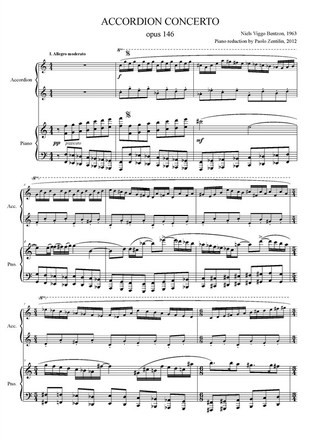Niels Viggo Bentzon (1919 - 2000)
|
Niels Viggo Bentzon was a Danish composer and organist. He was born in Copenhagen, 24th of August 1919 to a family of musicians. His mother's family belongs to one of the most eminent Danish musical families throughout more than 200 years. From mother's side he was descendant of the German immigrant Johan Ernst Hartmann, who also was organist and composer. On father's side his cousins were the composer Jorger Bentzon and the flautist Johan Bentzon.
Bentzon's mother was a pianist and it was from her that he recieved his first lessons on the piano. Later he got lessons from the jazz pianinst L. Mathisen. During the years 1938 - 1942 he studied piano, organ and music theory at the Royal Danish Academy of Music in Copenhagen. Niels Viggo Bentzon was a self-taught composer, but despite this, being only twenty years old, he was already recognized from the musical establishment. In 1943 Niels Viggo Bentzon made his debut as a pianist, he toured Europe and the USA. He became a teacher at the Royal Academy of Music in Aarhus, Denmark (1945 -1950) and at the Royal Danish Academy (1950 -1988). He also wrote criticism, published poetry and he was a painter. |
His compositions follow along avant-garde lines for the most part, encompassing happenings, audio-visual scores, and graphic notation. He wrote more than 650 works, often experimenting with avant-garde techniques but in generally tonal framework.
|
Bentzon had a big influence on the Danish music, not only because of his compositions but also because of his strong commitment in writing and speech to the ongoing aesthetic discussions of the latter half of the last century.
His music changed over the years under the influence of various currents, but we can say that he did keep his own typical style through his extensive oeuvre. He had a special view on making music. Bentzon's music can be seen as an alteration between his own strong will and inspiration from the contemporary scene. Throughout his carreer he wrote music the way and the kind he had in mind, regardless what the time spirit was. Bentzon experimented in the dodecafonic, at the moment that the institutions of the day were hermetically sealed off against German modernism; he was still neo when the 1970s composers re-opened the gates to classicism. He remained himself, while his music changed between being in or out of fashion. Most of Bentzon's music was written for piano. Composer Bentzon's need for control over the material, and pianist Bentzon's desire for free-wheeling fantasy, created a kind of music that has been described as "structured imporvisation". |
In his extensive oeuvre we find chamber music, symphonies, operas, works for string ensembles, but also works for accordeon.
|
Works for accordeon
Op. 146 Accordion Concerto Op. 164 In the zoo, for accordeon Op. 178 Sinfonia Concertante, No 1 for six accordeons and orchestra Op. 221 Columbus eier Salt and Pepper, for accordeon Op. 259 Duarder Suite for accordeon and persussion Op. 292 Melody and Rhytm, for accordeon Op. 353 Dialect, for violin and accordeon (graphic notation) Op. 407 Nocturne, for violin, cello, accordeon, 4H piano and percussion Sources: http://en.wikipedia.org/wiki/List_of_compositions_by_Niels_Viggo_Bentzon http://en.ewh.dk/Default.aspx?TabId=2449&State_2955=2&composerId_2955=103 http://www.bach-cantatas.com/Lib/Bentzon-Niels.htm |



